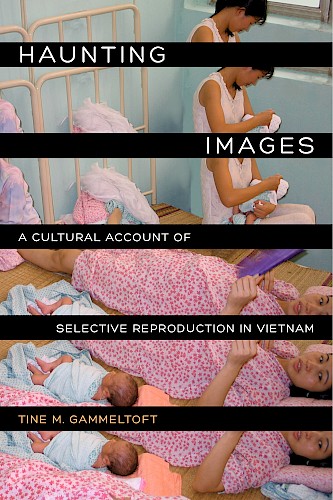Haunting images
A cultural account of selective reproduction in Vietnam
Tine Gammeltoft
— Reviewed by
Tine Gammeltoft, Haunting Images: A Cultural Account of Selective Reproduction in Vietnam. Berkeley:University of California Press, 2014. 314 pp., $34.95. ISBN 9780520278431.
Tine Gammeltoft’s Haunting Images is distinguished by a rare combination of strengths: theoretical acumen, rigorous area-studies grounding, and poignant, experience-near sensitivity to its subject matter. A study of ‘selective reproduction’ in contemporary Hanoi, Vietnam, this work addresses the predicament of women faced with an unbearable decision: whether to carry a child to term after prenatal screening has detected abnormalities. In Vietnam, the legacy of wartime dioxin spraying, the weakness of the social welfare system, and religio-moral significance ascribed to the body all structure a strong societal preference for physically normal children; however, the decision to terminate a pregnancy also causes anguish and trepidation. Through a series of case studies, Haunting Images intimately details the affective, moral, and social meanings that shape her respondents’ life-and-death decisions.
This deft and often moving volume makes a signature contribution to the growing anthropological literature on Vietnam, elevating expectations for theoretical ambition and subtlety of interpretation. The author’s long field experience in Northern Vietnam facilitated a robust longitudinal study design enriched by collaborations with Vietnamese professionals in medicine and social science. Over a three-year period, the author and her team of co-investigators interviewed women receiving 3D ultrasounds at Hanoi’s Obstetrics and Gynecology Hospital, ultimately working closely with thirty individuals whose pregnancies were found to be abnormal. The research group also met with medical workers and health policy makers, reviewed Vietnamese media and academic research, and conducted participant observation with families with disabled children.
Gammeltoft situates the use of obstetrical ultrasound scanning within the context of four highly politicized domains in Vietnamese society: ‘health, abortion, disability, and population’ (p. 30). The state currently places a high priority on the question of ‘population quality’; the enduring influence of Agent Orange on health outcomes in Vietnam is a particularly important factor motivating parents to seek ultrasounds. As a result, the antenatal encounter with the fetus is both highly anticipated and always already threatened by the potential necessity of sacrificing one’s child. Throughout the book’s chapters, Gammeltoft emphasizes how familism, scientism, cosmological and ethical knowledge, love, and the cultural valorization of motherhood interact to compel pregnant women to seek out this form of antenatal care. The central dilemma that her respondents face stems from their knowledge that this gesture of parental love may entail taking the unborn child’s life.
While an exploration of reproductive decision making might presume an atomistic subject of choice, the central theme of this analysis is collectivity. Faced with ‘the existential extrema of birth, death, and love’ (p. 9), the women in this book rarely confront their fate alone. The project of producing a next generation in Vietnam – as elsewhere – is saturated with forms of collective belonging, from the scale of the family to that of the nation. The opinions, priorities, and desires of husbands, parents, in-laws, medical authorities, and the state frequently influence a woman’s reproductive choices, such that choices may in fact come to constitute ‘acts of belonging’. An anomalous sonogram represents a crisis for a prospective mother and her family; however, it also presents an opportunity to express shared knowledge about human ontology, obligations to the unborn, and the definition of a life worth living. In this way, the subject matter of Haunting Images leads straight into the heart of concerns that are simultaneously social, spiritual, medical, and moral.
In her sensitivity to historic and cultural context as well as the predicaments of her interlocutors, Gammeltoft evinces the nuanced perspective of a near-insider, elegantly puncturing essentializing interpretations of Vietnamese social norms and cultural values. (She also takes care to resist imposing theoretical constructs that other scholars have perhaps applied too hastily to this setting – that postmarket reform Vietnam is ‘neoliberal’, for instance.) Though other authors might take the opportunity to offer critiques of health care systems that disserve less privileged patients, family systems that disserve women and children, and social systems that stigmatize disability and disadvantage, Gammeltoft maintains a thoroughgoing generosity of interpretation, humanizing systems as well as individuals.
Haunting Images achieves an unusually strong balance of offerings to readers. Area specialists will be engaged by Gammeltoft’s analysis of themes in contemporary Vietnam – including agency, collectivity, identity, morality, affect, gender, and disability. Scholars of reproductive health in other global settings will find this an important contribution to the literature; Haunting Images also supplies a valuable case study of bioethics and biopolitics in a non-Western, postsocialist context. Keenly observed and compellingly written, this volume will engage undergraduates and graduate students in cultural anthropology, medical anthropology, science and technology studies, and women’s and gender studies.
About the author
Martha Lincoln is a Postdoctoral Fellow at UC Berkeley School of Public Health and a medical anthropologist specializing in Vietnam. Her work is available at https://berkeley.academia.edu/MarthaLincoln/Papers.
